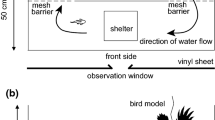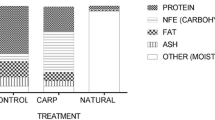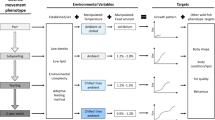Abstract
Cultured organisms undergo genetically-based behavioural changes that may reduce their ability to survive in the wild. This has raised concerns that interbreeding between escaped cultured and wild organisms will generate hybrids exhibiting maladaptive behaviours which may ultimately reduce the fitness of the wild counterpart. We compared anti-predator responses in Atlantic salmon (Salmo salar) from two wild North American populations, the major farmed strain used in regional aquaculture, and their wild-farmed hybrids (F1, F2, and wild backcross). Anti-predator responses of fry (age 0+ parr) were measured under common environmental conditions, using a model of a natural predator (belted kingfisher, Ceryle alcyon). Farmed fry exhibited significantly reduced anti-predator responses relative to fry from both wild populations. The anti-predator responses of wild-farmed hybrid fry were intermediate to those of the parental populations (pure farmed or wild). The magnitude by which wild-farmed hybrids differed in anti-predator responses from pure wild fish also depended on the wild population. These results suggest that: (1) the observed behavioural differences have a genetic basis; (2) wild-farmed hybrids have, on average, reduced anti-predator responses relative to wild fish; and that (3) the effects of wild-farmed interbreeding on anti-predator responses will differ between wild populations. Our study is consistent with the general hypothesis that continual farmed-wild interbreeding may have detrimental effects on the fitness of wild organisms.





Similar content being viewed by others
References
Cairns DK (1998) Diet of cormorants, mergansers, and kingfishers in northeastern North America. Can Tech Rep Fish Aquat Sci No 225
Committee on the Status of Endangered Wildlife in Canada (COSEWIC) (2006) COSEWIC assessment and update status report on the Atlantic salmon Salmo salar (Inner Bay of Fundy populations) in Canada. Available via www.sararegistry.gc.ca. Accessed 19 January 2009
Edmands S (1999) Heterosis and outbreeding depression in interpopulation crosses spanning a wide range of divergence. Evol Int J Org Evol 53:1757–1768. doi:10.2307/2640438
Einum S, Fleming IA (1997) Genetic divergence and interactions in the wild among native, farmed and hybrid Atlantic salmon. J Fish Biol 50:634–651. doi:10.1111/j.1095-8649.1997.tb01955.x
Fleming IA, Einum S (1997) Experimental tests of genetic divergence of farmed from wild Atlantic salmon due to domestication. ICES J Mar Sci 54:1051–1063
Fleming IA, Jonsson B, Gross MR (1994) Phenotypic divergence of sea-ranched, farmed, and wild salmon. Can J Fish Aquat Sci 51:2808–2824. doi:10.1139/f94-280
Fleming IA, Jonsson B, Gross MR et al (1996) An experimental study of the reproductive behaviour and success of farmed and wild Atlantic salmon (Salmo salar). J Appl Ecol 33:893–905. doi:10.2307/2404960
Fleming IA, Hindar K, Mjølnerød IB et al (2000) Lifetime success and interactions of farm salmon invading a native population. Proc R Soc Lond B Biol Sci 267:1517–1523. doi:10.1098/rspb.2000.1173
Fleming IA, Agustsson T, Finstad B et al (2002) Effects of domestication on growth physiology and endocrinology of Atlantic salmon (Salmo salar). Can J Fish Aquat Sci 59:1323–1330. doi:10.1139/f02-082
Frankham R (2008) Genetic adaptation to captivity in species conservation programs. Mol Ecol 17:325–333. doi:10.1111/j.1365-294X.2007.03399.x
Fraser DJ, Cook AM, Eddington JD et al (2008) Mixed evidence for reduced local adaptation in wild salmon resulting from interbreeding with escaped farmed salmon: complexities in hybrid fitness. Evol Appl 1:501–512. doi:10.1111/j.1752-4571.2008.00037.x
Freeman S, Herron JC (2004) Evolutionary Analysis, 3rd edn. Pearson Prentice Hall, Toronto
Garant D, Fleming IA, Einum S et al (2003) Alternative male life-history tactics as potential vehicles for speeding introgression of farm salmon traits into wild populations. Ecol Lett 6:541–549. doi:10.1046/j.1461-0248.2003.00462.x
Garcia de Leaniz CG, Fleming IA, Einum S et al (2007) A critical review of adaptive genetic variation in Atlantic salmon: implications for conservation. Biol Rev Camb Philos Soc 82:173–211. doi:10.1111/j.1469-185X.2006.00004.x
Gibson RJ (1993) The Atlantic salmon in fresh water: spawning, rearing and production. Rev Fish Biol Fish 3:39–73. doi:10.1007/BF00043297
Gjedrem T, Gjerde B, Refstie T (1988) A review of quantitative genetic research in salmonids at AKVAFORSK. In: Weir BS, Eisen EJ, Goodman MM et al. (eds) Proceedings of the Second International Conference on Quantitative Genetics, Sinauer Associates Inc, Sunderland
Glebe BD (1998) Atlantic salmon broodstock development programs. Can Stock Assess Secret Res Doc 98/157
Gotceitas V, Godin J-GJ (1993) Effects of aerial and in-stream threat of predation on foraging by juvenile Atlantic salmon (Salmo salar). In: Gibson RJ, Cutting RE (eds) Production of juvenile Atlantic salmon, Salmo salar, in natural waters, Can Spec Pub Fish Aquat Sci vol 118, pp. 35–41
Green BS (2009) Maternal effects in fish populations. Adv Mar Biol 54:1–105. doi:10.1016/S0065-2881(08)00001-1
Gross MR (1998) One species with two biologies: Atlantic salmon (Salmo salar) in the wild and in aquaculture. Can J Fish Aquat Sci 55:131–144. doi:10.1139/cjfas-55-S1-131
Hindar K, Fleming IA, McGinnity P et al (2006) Genetic and ecological effects of salmon farming on wild salmon: modelling from experimental results. ICES J Mar Sci 63:1234–1247. doi:10.1016/j.icesjms.2006.04.025
Hosey GR (1997) Behavioural research in zoos: academic perspectives. Appl Anim Behav Sci 51:199–207. doi:10.1016/S0168-1591(96)01104-5
Hutchings JA (1991) The threat of extinction to native populations experiencing spawning intrusions by cultured Atlantic salmon. Aquaculture 98:119–132. doi:10.1016/0044-8486(91)90377-J
Hutchings JA, Fraser DJ (2008) The nature of fisheries- and farming-induced evolution. Mol Ecol 17:294–313. doi:10.1111/j.1365-294X.2007.03485.x
Johnsson JI, Abrahams MV (1991) Interbreeding with domestic strains increases foraging under threat of predation in juvenile steelhead trout (Oncorhynchus mykiss): an experimental study. Can J Fish Aquat Sci 48:243–247. doi:10.1139/f91-033
Johnsson JI, Björnsson BT (1994) Growth hormone increases growth rate, appetite and dominance in juvenile rainbow trout, Oncorhynchus mykiss. Anim Behav 48:177–186. doi:10.1006/anbe.1994.1224
Johnsson JI, Petersson E, Jönsson E et al (1996) Domestication and growth hormone alter antipredator behaviour and growth patterns in juvenile brown trout, Salmo trutta. Can J Fish Aquat Sci 53:1546–1554. doi:10.1139/cjfas-53-7-1546
Jonsson B, Jonsson N (2006) Culture Atlantic salmon in nature: a review of their ecology and interactions with wild fish. ICES J Mar Sci 63:1162–1181. doi:10.1016/j.icesjms.2006.03.004
Lawlor J (2003) Genetic differences in fitness-related traits among populations of wild and farmed Atlantic salmon, Salmo salar. MSc thesis, Dalhousie University, Halifax
Lynch M, Walsh JB (1998) Genetics and analysis of quantitative traits. Sinauer Associates, Inc., Sunderland
McGinnity P, Prödohl P, Fergusin A et al (2003) Fitness reduction and potential extinction of wild populations of Atlantic salmon, Salmo salar, as a result of interactions with escaped farm salmon. Proc R Soc Lond B Biol Sci 270:2443–2450. doi:10.1098/rspb.2003.2520
McGinnity P, Prödohl P, Ó Maoiélidigh N et al (2004) Differential lifetime success and performance of native and non-native Atlantic salmon examined under communal natural conditions. J Fish Biol 65(Suppl. A):173–187. doi:10.1111/j.0022-1112.2004.00557.x
Morantz DL, Sweeney RK, Shirvell CS et al (1987) Selection of microhabitat in summer by juvenile Atlantic salmon (Salmo salar). Can J Fish Aquat Sci 44:120–129. doi:10.1139/f87-015
Morris MRJ, Fraser DJ, Heggelin AJ et al (2008) Prevalence and recurrence of escaped farmed Atlantic salmon (Salmo salar) in eastern North American rivers. Can J Fish Aquat Sci 65:2807–2826. doi:10.1139/F08-181
Price EO (1997) Behavioural genetics and the process of animal domestication. In: Grandin T (ed) Genetics and the behaviour of domestic animals. Academic Press, San Diego, pp 31–65
Quinton CD, McMillan I, Glebe BD (2005) Development of an Atlantic salmon (Salmo salar) genetic improvement program: genetic parameters of harvest body weight and carcass quality traits estimated with animal models. Aquaculture 247(Spec Issues 1–4):211–217 Genetics in Aquaculture VIII
Taylor EB (1991) A review of local adaptation in Salmonidae, with particular reference to Pacific and Atlantic salmon. Aquaculture 98:185–207. doi:10.1016/0044-8486(91)90383-I
Tymchuk WE, Biagi C, Withler R et al (2006) Growth and behavioral consequences of introgression of a domesticated aquaculture genotype into a native strain of coho salmon. Trans Am Fish Soc 135:442–455. doi:10.1577/T05-181.1
Verspoor E (1998) Genetic impacts on wild Atlantic salmon (Salmo salar L) stocks from escaped farm conspecifics: an assessment of risk. Can Stock Assess Secret Res Doc 98/156
Weir LK, Hutchings JA, Fleming IA et al (2005) Spawning behaviour and success of mature male Atlantic salmon (Salmo salar) parr of farmed and wild origin. Can J Fish Aquat Sci 62:1153–1160. doi:10.1139/f05-032
Zar JH (1999) Biostatistical analysis, 4th edn. Prentice-Hall, New Jersey
Acknowledgments
The work was supported by the Natural Sciences and Engineering Research Council (Canada) through an undergraduate student research award to ASH, a post-doctoral fellowship to DJF, and a Strategic Grant to JAH. ASH was also supported by an Atlantic Salmon Federation Olin Fellowship. We thank at Dalhousie University J. Eddington (Aquatron facility), M. Merrimen, R. Myers, K. Tae, L. Weir, and P. Debes. We also thank P. Amiro (Department of Fisheries and Oceans Nova Scotia Region), J.-G. Godin (Carleton University, Ottawa), A. Hebda (Natural History Museum of Nova Scotia), A. D-S. Houde (Saint Mary’s University, Halifax), the constructive comments of two anonymous reviewers, and E. Anderson. Petrie the belted kingfisher.
Author information
Authors and Affiliations
Corresponding author
Rights and permissions
About this article
Cite this article
Houde, A.L.S., Fraser, D.J. & Hutchings, J.A. Reduced anti-predator responses in multi-generational hybrids of farmed and wild Atlantic salmon (Salmo salar L.). Conserv Genet 11, 785–794 (2010). https://doi.org/10.1007/s10592-009-9892-2
Received:
Accepted:
Published:
Issue Date:
DOI: https://doi.org/10.1007/s10592-009-9892-2




